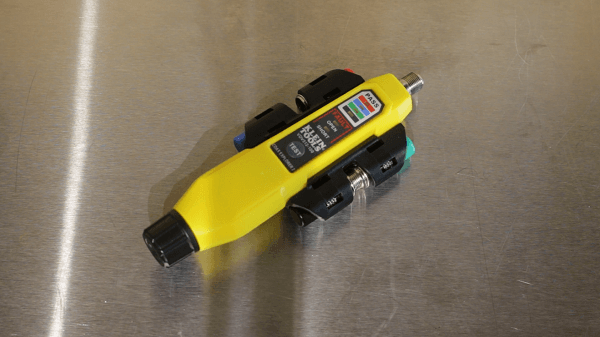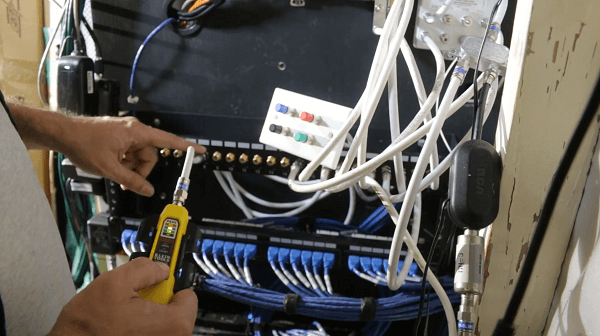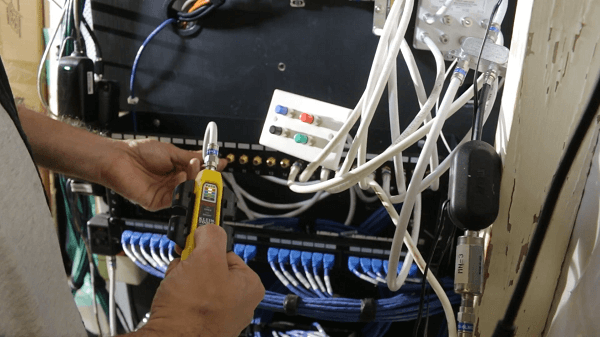Table of Contents
Are you having issues with tracing your coax cable? It could be difficult to locate these wires on your property because they may pass through the wall or roof.
Often, because of different situations such as physical, heat, or water damage, the coaxial cable gets compromised. If this issue develops, it becomes quite frustrating because you can no longer operate gadgets that heavily rely on the internet. Therefore, you need to locate your coax cable and test its functionality.
So, how can you trace your coax cable? This post outlines everything you need to know about tracing coax cables, including the different techniques you could use, how you can test if your cable is live, etc. So, let’s get cracking!
How To Trace a Coax Cable in Walls
Once you have installed coax connections in different rooms via walls, or even ceilings and floors, it becomes hard to trace the path of your coaxial cable.
Therefore, you must first trace the coax cable before running connectivity tests or installing a new home theater system or TV. Here are some simple steps to follow:
Gather the tools you need to find the coax cable path, such as a continuity tester, a navigator for the coax, and a roll of masking tape.
If you have more than one coaxial signal cable, you must match each end with the assistance of a cable splitter.
With a coaxial cable tester, plug one end of the tester into the wall and take the other end to where the cables come together. Connect every pin on the cable one at a time. If you hear a sound, you have selected the correct cable.
Suppose your coax cable’s other end is linked to your roof’s antenna or satellite dish. In that case, you could use an aluminum coil and a multimeter to find the appropriate ends of a particular coax cable. You should fill the aluminum foil at the end of the coax cables.
If you put the sensor of the multimeter on the end of the correct coax cable, the meter will read ‘0,’ but it will show different numbers for other cables.
You can use a coaxial cable mapper to locate and evaluate coaxial cables in multiple places.
If you have misplaced the coaxial cable in the attic or wall, you could use a coaxial toner probe to locate it. Once it detects a coaxial wire within the wall, it will emit a loud noise, allowing you to pinpoint the cable’s location.
How To Trace Coax Cable With Multimeter
You can use a digital multimeter with capacitance measuring capability to estimate the location of a damaged coaxial cable. This approach takes advantage of the capacitance per foot characteristics of coaxial wire.
Most contemporary digital multimeters include a capacitance testing function. If the coax cable manufacturer is recognized, refer to the cable’s data sheet specs. The specs will include the cable’s capacitance per foot. However, if the manufacturer’s data is unavailable, you can calculate this value based on the similar capacitance characteristics of most coaxial cables of a given type (for instance, RG58, RG59, RG6, etc.).
After determining the estimated capacitance per foot, attach the coax you’re testing to the multimeter. You can easily do this by removing the end of the coax cable or by constructing a short ‘pigtail’ connection that allows you to attach the existing coax connector to the meter.
Next, check the capacitance value shown on the multimeter and determine the distance to the circuit utilizing the capacitance per foot figure on the data sheet. This simple method provides great results, even when using a low-priced digital multimeter to measure.
Nonetheless, this approach does not replace a high-priced cable testing unit employing TDR measuring techniques. But still, it does provide a straightforward, dependable, and inexpensive solution for locating a coax cable in an existing system.
How To Tell if a Buried Coax Cable Is Live
Identifying if your signal is valid and active is essential for establishing viable Wi-Fi and internet connections. Here are some reliable ways to tell if a buried coax cable is live.
Manual Test
This technique includes shifting a modem from location to location. Using Cable Modem, you may physically check the coax outlet’s signal.
Remove the cable modem from the cable outlet and plug it into a different outlet. Then, connect it to every coax outlet. In doing so, you can verify the signal and connection. If your internet modem enables internet access, then there is signal detection. If the internet stays unavailable, it means there are no available signals.
Unfortunately, this manual technique is cumbersome and time-consuming. If you want to save time, try resorting to automated coax testers instead.
Coax Cable Tester
A Coax Cable Tester is simple, precise, and convenient to use. Unlike before, when you had to test every coax outlet with your modem for a viable Internet signal from your Internet provider, the coax tester automates this process. The coaxial cable tester provides reliable findings for valid transmissions.
Coax Explorer Tester
The Coax Explorer Tester examines and uncovers coaxial wires. It applies a simple single-button operation. The gadget produces easily interpretable findings, and the LED screen displays the criteria PASS, OPEN, and SHORT.
Moreover, the Coax Explorer® Tester simplifies the procedure of cable identification. A color-coded push-on remote enables the use of up to four wires simultaneously. The tester requires two A-size batteries. Insert the plug into the outlet and press the button. If active, the LED panel will receive signals.
How To Use a Coax Cable Tester
Follow these steps to examine your coaxial cable with a coax cable tester.
1. Set Up Your Coax Cable Tester

Put your Coax Cable Tester in your select outlet, and press the button. The tester immediately begins identifying nearby signals.
2. Check Out for the Green or Red Light

Once kickstarted, the Coax Cable Tester will display the results in under 10 seconds. These testers are equipped with a bright LED-light indicator that displays either red or green based on the signal status.
3. Interpret the Results of Your Test

If you observe a green light on your tester, it implies your cable is in good condition. You can connect your cable modem and begin enjoying the internet.
On the other hand, if the tester shows a red light, the Coax cable’s internet is either not connected or inactive. In this case, you should contact your Internet service provider to fix the issue.
Bonus Tip
Sometimes you might observe that your tester’s LED light is green, yet your internet remains unconnected. If so, then the issue lies in your cable modem.
Frequently Asked Questions
Here are the most common questions about coax cables and their answers.
What Are Coaxial Cables Used For?
Coaxial cables are thick wires that transport huge amounts of data, such as high-bandwidth Internet and cable television transmissions, from an Internet company or cable provider to the end-user.
Similar to power outlets, these cables and connectors are typically already fixed on the walls of most houses and apartment complexes.
How Do I Know if a Coax Connection Is Active?
Use a digital multimeter or non-contact voltage tester to check for a live electrical line.
A non-contact voltage tester is the safest approach for checking live wires, accomplished by positioning the equipment close to the wire.
How Do You Find Coax Cable in a Wall?
After locating the cable’s location, gently make a hole in the wall to extract the coaxial wire.
Ensure that the hole is smaller than the outlet cover to pass the coaxial cable through it and easily fit the outlet cover over the hole.
Can the Coaxial Cable Be Installed Outdoors?
With a few exceptions, you can install a coaxial cable in both outdoor and indoor environments.
Outdoor coax needs extra insulation to safeguard the wires. Along the exterior of your property, you could route cables approved for outdoor usage to a cable box or antenna.
Whether exposed to the sun or buried below, you must sufficiently shield the cable to ensure uninterrupted communications.
Are All Coax Cables the Same?
Whereas you can apply all coaxial cables for signal transmission, they are not identical.
Coaxial cables differ in dimensions, composition, and shielding. Every type of coaxial cable is optimal for specific uses.
Does It Matter What Coaxial Cable I Use?
Yes! A signal booster may require a distinct wire from radio systems.
It is crucial to choose an application-appropriate cable for optimal results.
What Distinguishes Coaxial Cable From Other Shielded Cables?
Unlike other shielded cables, there are specific standards for diameters of coaxial cables.
Regulating the cable size helps achieve the exact and continuous conductor spacing. It is essential for creating good functioning while transmitting signals at lower frequencies.
What Is the Speed of Transmission for a Coaxial Cable?
The data transmission rate of coaxial cables relies on the cable type and the underlying technology.
The average transmission speed of coaxial cable spans from 10 Mbps to over 100 Mbps.
How can you find out if a coax cable is connected to the main system?
The best way to find out if the coax cable is connected to the main system is to test the cable. Try turning on the internet or the television and see if everything works. If they do, then your coax cable is connected.
Do Coax Cable Go Bad?
A coaxial cable may remain undamaged for decades. However, it can deteriorate over time.
The primary causes of damage are:
- Heat damage: The plastic wrap may melt if subjected to high temperatures for an extended period. It damages the unsecured interior components.
- Physical damage: Folding coax cable or stomping on it can wreak havoc on its inner components, compromising transmission.
- Water damage: Water within the cable might harm the electrical components. Based on the extent, it may impair performance or make the cable ineffective.
- Connection damage: If a connector dislodges, corrodes, or breaks, the cable cannot effectively carry information from one source to another.
Purchasing the proper coaxial cable is the first step in extending its life. Subsequently, ensure proper installation, weatherproof the connections, and do not bend them.
Tracing A Coax Cable
With increased reliance on the internet, coax cables are indispensable. Occasionally, though, because of defects or problems with internet connectivity, you might want to trace the coax cable.
Hopefully, this article has taught you all you wanted about tracing a coax cable. By now, you should understand how to use a Coax Cable Tester. With this information, you need not always contact a technician to repair your internet connection problems.

